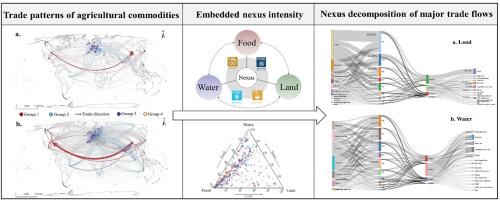水-土地-粮食关系揭示了中等收入经济体日益增长的资源出口压力
IF 11.2
1区 环境科学与生态学
Q1 ENGINEERING, ENVIRONMENTAL
引用次数: 0
摘要
水、土地和粮食是农业供应链的重要组成部分,但它们之间的相互联系仍不明确。在此,我们利用多地区投入产出和关联指数,分析了农业贸易对水和土地效率的影响。从 1995 年到 2015 年,农产品中平均有 38.07% 的土地使用和 28.27% 的水消耗被用于区域间贸易。总体而言,从资源丰富的欠发达经济体向资源贫乏的发达经济体转移的贸易流提高了全球范围内的资源效率,平均土地效率和用水效率分别提高了68.23%和56.11%。但商品出口的增长强度限制了出口国资源效率的提高,特别是在巴西、印度和印度尼西亚等中等净出口国。不同商品的土地和水资源转移压力各不相同。农作物类产品占水资源流量的 72.39%,肉类产品占土地资源流量的 67.61%。其中,蔬菜、水果和坚果的水-地-粮关系最为密切,在全球资源转移模式中发挥着越来越重要的作用。研究通过计算水-陆-粮关系的效率,为可持续农业管理提出了有针对性的措施。本文章由计算机程序翻译,如有差异,请以英文原文为准。

The Water-Land-Food nexus reveals growing resource export pressure in middle-income economies
Water, land, and food constitute essential components of agricultural supply chains, yet their interconnections remain unclear. Here we used the multi-regional input-output, in conjunction with the nexus index, to analyze the impact of agricultural trade on water and land efficiency. An average of 38.07 % of land use and 28.27 % of water consumption embedded in agricultural commodities was used for interregional trade from 1995 to 2015. Overall, the trading flows transferring from resource-rich and underdeveloped economies to resource-poor and developed economies enhanced the resource efficiency on a global scale, with average land and water efficiency rising by 68.23 % and 56.11 %, respectively. But the growth intensity of commodities’ exports has limited the improvement of resource efficiency in exporting countries, particularly in net middle-income exporters such as Brazil, India, and Indonesia. The pressure of land and water transfers varies across commodities. Crop-based products account for 72.39 % of water resource flow, while meat-based products account for 67.61 % of land resource flow. Among these, vegetable, fruit, and nut, which have the highest water-land-food nexus, is playing an increasingly significant role in the global pattern of resource transfer. The study proposed targeted measures for sustainable agricultural management through efficiency calculation in Water-Land-Food nexus.
求助全文
通过发布文献求助,成功后即可免费获取论文全文。
去求助
来源期刊

Resources Conservation and Recycling
环境科学-工程:环境
CiteScore
22.90
自引率
6.10%
发文量
625
审稿时长
23 days
期刊介绍:
The journal Resources, Conservation & Recycling welcomes contributions from research, which consider sustainable management and conservation of resources. The journal prioritizes understanding the transformation processes crucial for transitioning toward more sustainable production and consumption systems. It highlights technological, economic, institutional, and policy aspects related to specific resource management practices such as conservation, recycling, and resource substitution, as well as broader strategies like improving resource productivity and restructuring production and consumption patterns.
Contributions may address regional, national, or international scales and can range from individual resources or technologies to entire sectors or systems. Authors are encouraged to explore scientific and methodological issues alongside practical, environmental, and economic implications. However, manuscripts focusing solely on laboratory experiments without discussing their broader implications will not be considered for publication in the journal.
 求助内容:
求助内容: 应助结果提醒方式:
应助结果提醒方式:


